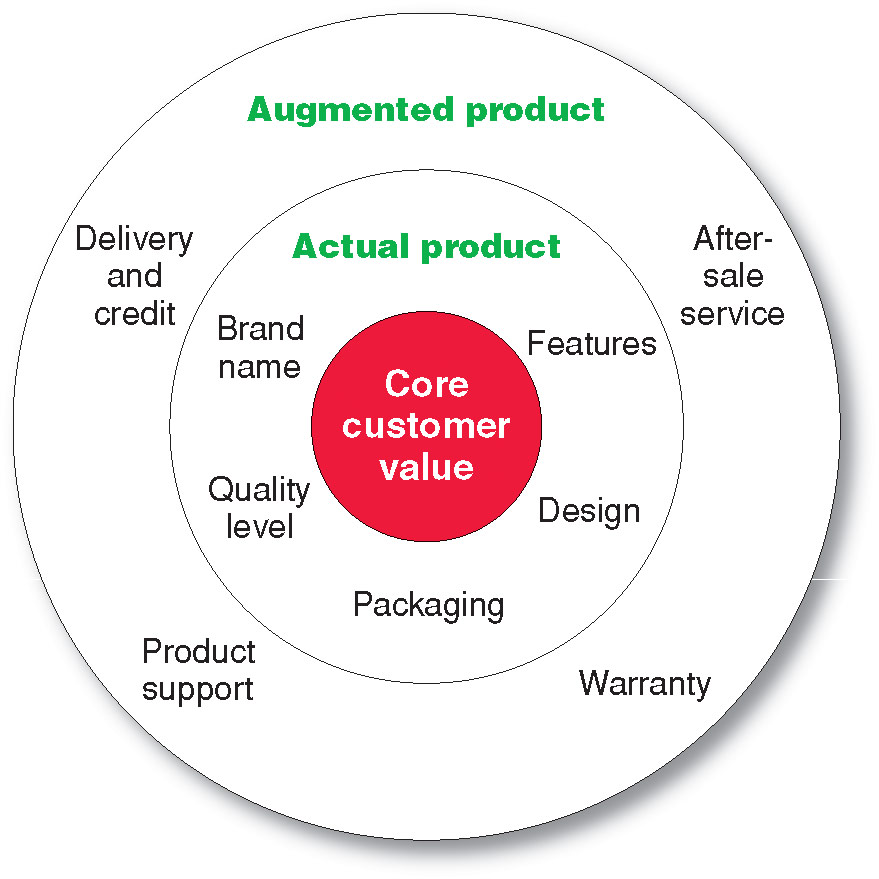Site pages
Current course
Participants
General
Module 3. Marketing Management
Lesson 12. Product Development and Product Lifecycle
12.1 INTRODUCTION
In this chapter we will be studying the meaning of product, different levels of product, classification of products, process of new product development and finally the stages of product lifecycle. The studies have shown the before coming to a successful or even usable idea for new product development, it has to come up with thousands of ideas. Therefore it would be interesting to know how a company goes through different steps in developing a new product. After launching a new product, management wants the product to stay in the market for long time. Therefore, finally we will discuss about the product life-cycle.
12.2 PRODUCT AND LEVELS OF PRODUCT
Product: It is defined as anything that can be offered to a market for attention, acquisition, use or consumption that might satisfy a want or need. Products include more than just tangible goods. Broadly defined products include physical objects, services, events, persons, places, organisations, ideas, or mixes of these entities.
Product planners need to think about products on three levels (fig 12.1). Each level adds more customer value. The most basic is the core benefit, which addresses the question, what is the buyer really buying? When designing products, marketers must first define the core, problem-solving benefits that consumer seeks.
At the second level, product planners must turn the core benefit into an actual product. They need to develop product and service features, design, a quality level, a brand name and packaging.
Finally, product planners must build an augmented product around the core benefit and actual product by offering additional consumer services and benefits.
12.3 PRODUCT CLASSIFICATIONS
Products may be classified into two broad classes based on the types of consumers that use the products. They are consumer products and industrial products.
-
Consumer Products: Products bought by final consumers for personal consumption. Marketers usually classify these products further based on how consumers go about buying them. They are as follows,
-
Convenience Products: Consumer products that the consumer usually buys frequently, immediately, and with a minimum of comparison and buying efforts.
-
Figure 12.1: Three levels of product
Examples include, soap, newspapers, fast food etc. Convenience products are usually low priced, and marketers place them in many locations to make them readily available when consumers need them.
Shopping Product: Consumer good that the customer, in the process of selection and purchase, characteristically compares on such bases as suitability, quality, price and style. Examples, furniture, clothing, major appliances etc.
Specialty Product: Consumer product with unique characteristics or brand identification for which a significant group of buyers is willing to make a special purchase effort. Examples, specific brands of cars, designer clothes, services of medical and legal specialists etc.
Unsought Products: Consumer product that the consumer either does not know about or knows about but does not normally think of buying. Example, insurance.
Industrial Products: Product bought by individuals and organisations for further processing of for use in conducting a business. The three groups of industrial products include materials and parts, capital items, and supplies and services.
12.4 TERMINOLOGIES USED IN PRODUCT MIX DICISIONS
Product line: A group of products that are closely related because they function in a similar manner, are sold to the same customer groups, are marketed through the same type of outlets, or fall within given price range. Example, Nike produces several lines of athletic shoes and apparel.
Product line length: The number of items in the product line.
Product mix or Product portfolio: The set of all product lines and items that a particular seller offers for sale.
Product mix width: It refers to the number of different product lines the company carries.
Product mix length: It refers to the total number of items the company carries within the product lines.
Product mix depth: Refers to the number of versions offered of each product in the line.
Consistency of product mix: refers to how closely related the various product lines are in end use, production requirements, distribution channels, or some other way.
12.5 NEW PRODUCT DEVELOPMENT PROCESS
A firm can obtain new product through two ways, either by acquisition or by new-product development in company’s own R&D department. Here, new product means, development of original products, product improvements, product modifications and new brands through the firm’s own R&D efforts.
Do all new products succeed? Obviously the answer is no. Studies indicate that up to 90% of all new consumer product fail. According to Harward Business Review, 2006, of 3000 new food, beverages and beauty products launched each year, 70-90% products fail within just 12 months. The question arises, why do they fail? The possible reasons are as follows.
Though the idea may be good, company may overestimate market size
Actual product may be poorly designed
Product may be incorrectly positioned
May be launched at wrong time
Product may not be priced correctly
May be poorly advertised, etc.
All this makes study of new product development process more important.
New product development process involves following steps.
a) Idea Generation: It is systematic search for new product ideas. Here the emphasis of the management will be to obtain as many as ideas as possible. The source of ideas may be either internal viz, executives, scientists, engineers, manufacturing staff and sales people, or external viz, customer, competitors, distributors & suppliers, magazines, shows & seminars, research institutions, universities, market research firms, etc.
b) Idea Screening: This is the second step, where the emphasis will be on reducing the number of ideas generated. The objective is to spot good ideas & drop poor ones as soon as possible.
c) Concept Development & Testing: Product concept is the detailed version of the new product idea stated in meaningful customer terms. Once the product concept is developed
d) Market Strategy & Development
e) Business Analysis
f) Product Development
g) Test Marketing
h) Commercialisation
